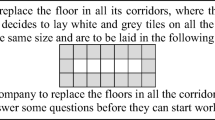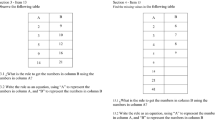Abstract
This study describes how 24 third graders (8–9 years old) relate and represent the relationships between variables when working with a functional thinking problem. This aspect contributes to providing insights about how elementary school students attend properties and relationships between covarying quantities rather than isolated computations. From a functional approach to early algebra, we describe written students’ answers when working with a problem that involves a function, which includes questions for specific values and to generalize. Design research guidelines, specifically those set out for Classroom Teaching Experiment were followed. This study addresses the fourth and last Classroom Teaching Experiment session, which involved a function of the type y = ax + b and students had not previously worked it. Students primarily evidenced correspondence relationship, using natural language and numerical representation to express this functional relationship. Our findings let us to state that (a) although students were not used to working with these types of problems, eleven of them go beyond arithmetic computations, finding relationships that relate the variables; and (b) three students generalized using natural language as a useful vehicle, while there are other students who perceived the same regularity for different specific values but they are unable to represent generalization clearly.











Similar content being viewed by others
Notes
In this study, we focus on external representations to distinguish them from mental or internal ones. Therefore, every time we mention the term “representation” or “representations,” we refer to external representations, made with pencil or paper, which are intentional, permanent, and have a spatial nature.
References
Ayala-Altamirano, C., & Molina, M. (2019). Meanings attributed to letters in functional contexts by primary school students. International Journal of Science and Mathematics Education, 18(7), 1271–1291.
Ayalon, M., Watson, A., & Lerman, S. (2015). Functions represented as linear sequential data: Relationships between presentation and student responses. Educational Studies in Mathematics, 90(3), 321–339.
Blanton, M. L., Brizuela, B. M., Gardiner, A., Sawrey, K., & Newman-Owens, A. (2015). A learning trajectory in 6-year-olds’ thinking about generalizing functional relationships. Journal for Research in Mathematics Education, 46(5), 511–558.
Blanton, M. L., Levi, L., Crites, T., & Dougherty, B. J. (2011). Developing essential understanding of algebraic thinking for teaching mathematics in grades 3–5. NCTM.
Brizuela, B., & Earnest, D. (2008). Multiple notational systems and algebraic understanding: The case of the “best deal” problem. In J. J. Kaput, D. W. Carraher, & M. L. Blanton (Eds.), Algebra in the early grades (pp. 273–302). LEA.
Bush, S. B., & Karp, K. S. (2013). Prerequisite algebra skills and associated misconceptions of middle grade students: A review. The Journal of Mathematical Behavior, 32(3), 613–632.
Cai, J. (2005). US and Chinese teachers’ constructing, knowing and evaluating representations to teach mathematics. Mathematical Thinking and Learning, 7(2), 135–169.
Cai, J., & Knuth, E. (2005). Introduction: The development of students’ algebraic thinking in earlier grades from curricular, instructional and learning perspectives. ZDM, 37(1), 1–4.
Cañadas, M. C., Brizuela, B. M., & Blanton, M. L. (2016). Second graders articulating ideas about linear functional relationships. The Journal of Mathematical Behavior, 41, 87–103.
Cañadas, M. C., & Castro, E. (2007). A proposal of categorisation for analysing inductive reasoning. PNA, 1(2), 67–78.
Carpenter, T. P., & Franke, M. (2001). Developing algebraic reasoning in the elementary school: Generalisation and proof. In H. Chick, K. Stacey, J. Vincent, & J. Vincent (Eds.), The future of the teaching and learning of algebra. Proceedings of the 12th ICMI study conference (Vol. 1, pp. 155–162). ICMI.
Carraher, D. W., & Schliemann, A. (2007). Early algebra and algebraic reasoning. In F. Lester (Ed.), Second handbook of research on mathematics teaching and learning (pp. 669–705). NCTM.
Carraher, D. W., Schliemann, A. D., & Schwartz, J. L. (2008). Early algebra is not the same as algebra early. In J. J. Kaput, D. W. Carraher, & M. L. Blanton (Eds.), Algebra in the early grades (pp. 235–272). LEA.
Confrey, J., & Smith, E. (1994). Exponential functions, rates of change, and the multiplicative unit. Educational Studies in Mathematics, 26(2–3), 135–164.
Dienes, Z. P. (1961). On abstraction and generalisation. Harvard Educational Review, 31(3), 281–301.
Kaput, J. J. (1991). Notations and representations as mediators of constructive processes. In E. V. Glasersfeld (Ed.), Radical constructivism in mathematics education (pp. 53–74). Springer.
Kaput, J. J. (2008). What is algebra? What is algebraic reasoning? In J. Kaput, D. Carraher, & M. Blanton (Eds.), Algebra in the early grades (pp. 5–17). LEA.
Kelly, A. E., & Lesh, R. A. (2000). Research design in mathematics and science education. Lawrence Erlbaum Associates.
Kieran, C., Pang, J., Schifter, D., & Fong, S. (2016). Early algebra. Research into its nature, its learning, its teaching. Springer.
Küchemann, D. (1981). Algebra. In K. Hart (Ed.), Children’s understanding of mathematics: 11–16 (pp. 102–119). : John Murray.
Kuckartz, U. (2019). Qualitative text analysis: A systematic approach. In G. Kaiser & N. Presmeg (Eds.), Compendium for early career researchers in mathematics education (pp. 181–198). Springer.
Lins, R., & Kaput, J. (2004). The early development of algebraic reasoning: The current state of the field. In K. Stacey, H. Chick, & M. Kendal (Eds.), The future of the teaching and learning of algebra: The 12th ICMI study (pp. 47–70). Kluwer.
Mason, J. (1996). Expressing generality and roots of algebra. In B. Bednarz, C. Kieran, & L. Lee (Eds.), Approaches to algebra (pp. 65–86). Kluwer.
Mason, J. H., Grahamn, A., Pimm, D., & Gowar, N. (1985). Routes to/roots of algebra. The Open University Press.
Morales, R., Cañadas, M. C., Brizuela, B. M., & Gómez, P. (2018). Relaciones funcionales y estrategias de alumnos de primero de educación primaria en un contexto funcional [Functional relationships and strategies of first graders in a functional context]. Enseñanza de las Ciencias, 36(3), 59–78.
Panorkau, N., & Maloney, A. (2016). Early algebra: Expressing covariation and correspondence. Teaching Children Mathematics, 23(2), 90–99.
Pinto, E., & Cañadas, M. C. (2018). Generalization in fifth graders within a functional approach. PNA, 12(3), 173–184.
Pinto, E., & Cañadas, M. C. (2021). Generalization of third and fifth graders from a functional approach to early algebra. Mathematics Education Research Journal, 33, 113–134.
Radford, L. (2018). The emergence of symbolic algebraic thinking in primary school. In C. Kieran (Ed.), Teaching and learning algebraic thinking with 5- to 12-years-olds (pp. 3–25). Springer.
Rivera, F. (2013). Teaching and learning patterns in school mathematics. Psychological and pedagogical considerations. Springer.
Romberg, T., Fennema, E., & Carpenter, T. (1993). Integrating research on the graphical representation of functions. Routledge.
Schhreier, M. (2012). Qualitative content analysus in practice. Sage.
Sfard, A. (1991). On the dual nature of mathematical conceptions: Reflections on processes and objects as different sides of the same coin. Educational Studies in Mathematics, 22(1), 1–36.
Smith, E. (2003). Stasis and change: Integrating patterns, functions, and algebra throughout the K-12 curriculum. In J. Kilpatrick, W. G. Martin, & D. Schifter (Eds.), A research companion to principles and standards for school mathematics (pp. 136–150). NCTM.
Smith, E. (2008). Representational thinking as a framework for introducing functions in the elementary curriculum. In J. J. Kaput, D. W. Carraher, & M. L. Blanton (Eds.), Algebra in the early grades (pp. 133–163). LEA.
Stephens, A. C., Ellis, A. B., Blanton, M. L., & Brizuela, B. M. (2017). Algebraic thinking in the elementary and middle grades. In J. Cai (Ed.), Compendium for research in mathematics education (pp. 386–420). NCTM.
Vinner, S., & Dreyfus, T. (1989). Images and definitions for the concept of function. Journal for Research in Mathematics Education, 20(4), 356–366.
Warren, E., Miller, J., & Cooper, T. J. (2013). Exploring young students’ functional thinking. PNA, 7(2), 75–84.
Wilkie, K. J. (2016). Students’ use of variables and multiple representations in generalizing functional relationships prior to secondary school. Educational Studies in Mathematics, 93(3), 333–361.
Williams, S. R. (1993). Mathematics and being in the world: Toward an interpretative framework. For the Learning of Mathematics, 13(2), 2–7.
Yerushalmy, J., & Schwartz, J. (1993). Seizing the opportunity to make algebra mathematically and pedagogically interesting. In T. A. Romberg, E. Fennema, & T. P. Carpenter (Eds.), Integrating research on the graphical representation of function (pp. 41–68). Routledge.
Acknowledgements
This study was conducted under National R&D Project EDU2016-75771-P funded by the Spanish Ministry of Economy and Competitiveness; the first author benefited from a PhD. grant awarded the by Chilean Government through the Comisión Nacional de Investigación Científica y Tecnológica (CONICYT), folio 72160307-2015.
Author information
Authors and Affiliations
Corresponding author
Rights and permissions
About this article
Cite this article
Pinto, E., Cañadas, M.C. & Moreno, A. Functional Relationships Evidenced and Representations Used by Third Graders Within a Functional Approach to Early Algebra. Int J of Sci and Math Educ 20, 1183–1202 (2022). https://doi.org/10.1007/s10763-021-10183-0
Received:
Accepted:
Published:
Issue Date:
DOI: https://doi.org/10.1007/s10763-021-10183-0




